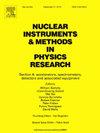通过基于诱导电场的电荷收集消除硅粒子探测器中的死层
IF 1.4
3区 物理与天体物理
Q3 INSTRUMENTS & INSTRUMENTATION
Nuclear Instruments & Methods in Physics Research Section A-accelerators Spectrometers Detectors and Associated Equipment
Pub Date : 2024-11-10
DOI:10.1016/j.nima.2024.170064
引用次数: 0
摘要
半导体粒子探测器的前表面通常包含未耗尽的重组活跃区,撞击粒子在到达器件的敏感区域之前会穿过这些区域。这些所谓的 "死层 "对可实现的能量分辨率构成了根本性的限制,在外部掺杂 pn 结探测器中是不可避免的。在这里,我们采用另一种电荷收集方法制造了硅粒子探测器,该方法将敏感区域扩展到了器件的前表面,并最大限度地减少了死层。该结点是通过在探测器表面使用带电薄膜诱导电场来实现的。这种方法以前曾在光电二极管中应用过,结果表明能有效收集器件表面的电荷载流子。我们的探测器漏电流和重组率都很低,这使得整个器件都能有效地收集电荷,该器件出色的内部量子效率也证明了这一点。以检测α粒子为例,进一步说明了该探测器的特点。我们实现了 20 千伏的能量分辨率,这与商用外部掺杂硅粒子探测器的水平相当,而无需对器件进行大量优化。值得注意的是,该设计显示出探测浅穿透带电粒子的前景,这对死层非常敏感。本文章由计算机程序翻译,如有差异,请以英文原文为准。
Elimination of dead layer in silicon particle detectors via induced electric field based charge collection
The front surface of semiconductor particle detectors typically contains undepleted recombination active regions that the impinging particles pass through before reaching the sensitive area of the device. These so-called dead layers pose a fundamental limitation for achievable energy resolutions and are unavoidable in externally doped pn-junction detectors. Here, we fabricate a silicon particle detector using an alternative method for charge collection that extends the sensitive region to the front surface of the device and minimizes the dead layer. The junction is realized by inducing an electric field at the surface of the detector using a charged thin film. Such an approach has previously been implemented in photodiodes, which have demonstrated effective collection of charge carriers from the very surface of the devices. Our detector displays low leakage currents and recombination, which allow efficient charge collection throughout the device, as demonstrated by excellent internal quantum efficiency of the device. The detector is further characterized using detection of alpha particles as a case example. We achieve 20 keV energy resolutions that are, already without extensive device optimization, on the same level with commercial externally doped silicon particle detectors. Notably, the design shows promise for detection of shallow penetrating charged particles, which is very sensitive to dead layers.
求助全文
通过发布文献求助,成功后即可免费获取论文全文。
去求助
来源期刊
CiteScore
3.20
自引率
21.40%
发文量
787
审稿时长
1 months
期刊介绍:
Section A of Nuclear Instruments and Methods in Physics Research publishes papers on design, manufacturing and performance of scientific instruments with an emphasis on large scale facilities. This includes the development of particle accelerators, ion sources, beam transport systems and target arrangements as well as the use of secondary phenomena such as synchrotron radiation and free electron lasers. It also includes all types of instrumentation for the detection and spectrometry of radiations from high energy processes and nuclear decays, as well as instrumentation for experiments at nuclear reactors. Specialized electronics for nuclear and other types of spectrometry as well as computerization of measurements and control systems in this area also find their place in the A section.
Theoretical as well as experimental papers are accepted.

 求助内容:
求助内容: 应助结果提醒方式:
应助结果提醒方式:


